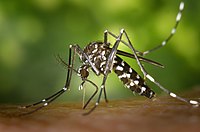
Photo from wikipedia
Simple Summary Diverse strains of Wolbachia bacteria, carried by many arthropods, as well as some nematodes, interact in many different ways with their hosts. These include male killing, reproductive incompatibility,… Click to show full abstract
Simple Summary Diverse strains of Wolbachia bacteria, carried by many arthropods, as well as some nematodes, interact in many different ways with their hosts. These include male killing, reproductive incompatibility, nutritional supplementation and suppression or enhancement of the transmission of diseases such as dengue and malaria. Consequently, Wolbachia have an important role to play in novel strategies to control human and livestock diseases and their vectors. Similarly, cell lines derived from insect hosts of Wolbachia constitute valuable research tools in this field. During the generation of novel cell lines from mosquito and sand fly vectors, we isolated two strains of Wolbachia and demonstrated their infectivity for cells from a range of other insects and ticks. These new insect cell lines and Wolbachia strains will aid in the fight against mosquitoes, sand flies and, potentially, ticks and the diseases that these arthropods transmit to humans and their domestic animals. Abstract Endosymbiotic intracellular bacteria of the genus Wolbachia are harboured by many species of invertebrates. They display a wide range of developmental, metabolic and nutritional interactions with their hosts and may impact the transmission of arboviruses and protozoan parasites. Wolbachia have occasionally been isolated during insect cell line generation. Here, we report the isolation of two strains of Wolbachia, wPip and wPap, during cell line generation from their respective hosts, the mosquito Culex pipiens and the sand fly Phlebotomus papatasi. wPip was pathogenic for both new C. pipiens cell lines, CPE/LULS50 and CLP/LULS56, requiring tetracycline treatment to rescue the lines. In contrast, wPap was tolerated by the P. papatasi cell line PPL/LULS49, although tetracycline treatment was applied to generate a Wolbachia-free subline. Both Wolbachia strains were infective for a panel of heterologous insect and tick cell lines, including two novel lines generated from the sand fly Lutzomyia longipalpis, LLE/LULS45 and LLL/LULS52. In all cases, wPip was more pathogenic for the host cells than wPap. These newly isolated Wolbachia strains, and the novel mosquito and sand fly cell lines reported here, will add to the resources available for research on host–endosymbiont relationships, as well as on C. pipiens, P. papatasi, L. longipalpis and the pathogens that they transmit.
Journal Title: Insects
Year Published: 2021
Link to full text (if available)
Share on Social Media: Sign Up to like & get
recommendations!